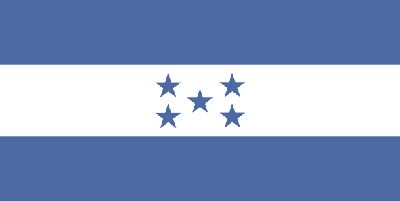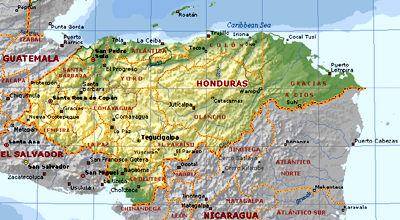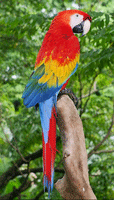|
Three horizontal bands of blue, white, and
blue with five blue, five-pointed stars in the center; the stars represent
the members of the former Federal Republic of Central America - Costa Rica,
El Salvador, Guatemala, Honduras, and Nicaragua; compare to the flags of
Nicaragua and Honduras. |
|
NAME: República de Honduras. The name has three etymologies: (1)
Guaymuras (a town named by
POPULATION: 8,000,000 (2010)
ETHNIC GROUPS: Mestizo (90%); Amerindian (7%)
CAPITAL: Tegucigalpa, (1,200,000)
INDEPENDENCE DAY: September 15, 1821 (independence from Spain)
LANGUAGES: Official language: Spanish
RELIGION: Roman Catholic (97%)
LIFE EXPECTANCY: Men (68); women (71)
LITERACY: 80%
GOVERNMENT: Democratic constitutional republic
President:
President Porfirio Lobo Sosa (2010 - present)
Legislature:
Unicameral National Congress
MILITARY: Army, Navy (Naval Infantry), Fuerza Aérea Hondureña,
FAH
ECONOMY: Exports: sugar, coffee, textiles, clothing, and wood products.
MONEY: lempiras (HNL); 18.9 HNL / $1.00 USD
GEOGRAPHY:
INTERNET CODE: .hn
|
Honduras’ national bird
is the Scarlet Macaw. It is
native to the lowland humid evergreen tropical forest regions in the
Americas, from southern Mexico to the Amazonian basin in eastern Peru and
throughout Brazil. It has been widely exterminated by capture by human beings
for the pet trade and by destruction of its habitat. According to Lora Kim
Joyner (liberatingwings.com) only 200 Scarlet Macaws remain in the wild in
the Maya Biosphere near Flores and Tikal. The bird measures up to 36 inches
long, and it can weigh up to 2.5 pounds. Half of the Macaw’s length is
made up by its typical pointed tail. Feathers are mostly scarlet, but its
rump and and tail feathers are light blue; its upper wings are are yellow;
the upper sides of the flight feathers and the tips of its tail feathers are
dark blue; the bottom sides of its wings and tail feathers are dark red with
a golden glow. Thay make loud, squawks, squeaks and screams in their throats,
and their cries can reach many miles away. |
NATIONAL BIRD:
HISTORY:
11,000 BCE (or up to 34,000 BCE): pre-Colombian settlers
300BCE-900CE
1502 Columbus
coasted along the Caribbean shores of Honduras. He landed at a place on the
middle of the northern coast he named Punta de Caxinas, and he called the
region of the coast Golfo de Honduras (“depths”) because the water
was so deep in this area. (What is the HUM 2461 term for this process?)
1524 Hernán
Cortés ordered a town named Triunfo de la Cruz (“triumph of the
cross;” why this name?) built near Punta de Caxinas. The name Triunfo de
la Cruz was later changed to Trujillo, which became Honduras’ first
capital. Because of pirate attacks along the coast, the capital was moved to
Comayagua in 1540: find it 80 miles NW of Tegucigalpa.
1525 Cortés
came to Honduras on his disastrous expedition with the Aztec emperor
Cuauhtémoc looking for gold and adventure.
1539 Pedro
de Alvarado completed Spanish control over
1540 The
capital of this part of the Viceroyalty of New Spain (Nueva España) was
moved to Santiago de Guatemala (now called Antigua Guatemala), but Honduras
retained its own local capital.
1821
1821-1838
1880 The capital was moved to Tegucigalpa, Honduras’ current capital.
1929 United
Fruit Company (of
1932-1948 Dictatorship of Tiburcio Carías.
1960-1982 Military dictatorships ruled the country.
1982 Democratic elections were held, and the current Constitution was promulgated.
1995
1998 A hurricane devasted the country killing nearly 6,000 people.
2006 President Manuel Zelaya Rosales was elected president.
2009 Coup d’état (golpe de estado) by military against President Zelaya. Announced reason: military, congress, and courts were opposed to a referendum President Zelaya attempted to hold ostensibly so that he could run for president again when his current term was up in January, 2010 (Honduras has one four-year term limits for presidents).
2010 Porfirio Lobo Sosa (b. 1947) becomes President; Manuel Zelaya begins exile in La República Dominicana; President Lobo authorizes amnesty for Zelaya and his alleged crimes.
PRINCIPAL
POLITICAL PARTIES:
Christian Democratic Party (PDC)
Democratic Unification Party (PUD)
Liberal Party (PL)
National Innovation and Unity Party (PINU)
National Party of Honduras (PN; center-right conservative)
CULTURE:
A Honduran is known familiarly in Spanish as catracho /-a. The word comes from Nicaraguans who referred to hondureños by the last name of French Honduran Gen. Florencio Xatruch. This general led the Honduran army against the invasion by American adventurer William Walker in 1857.




